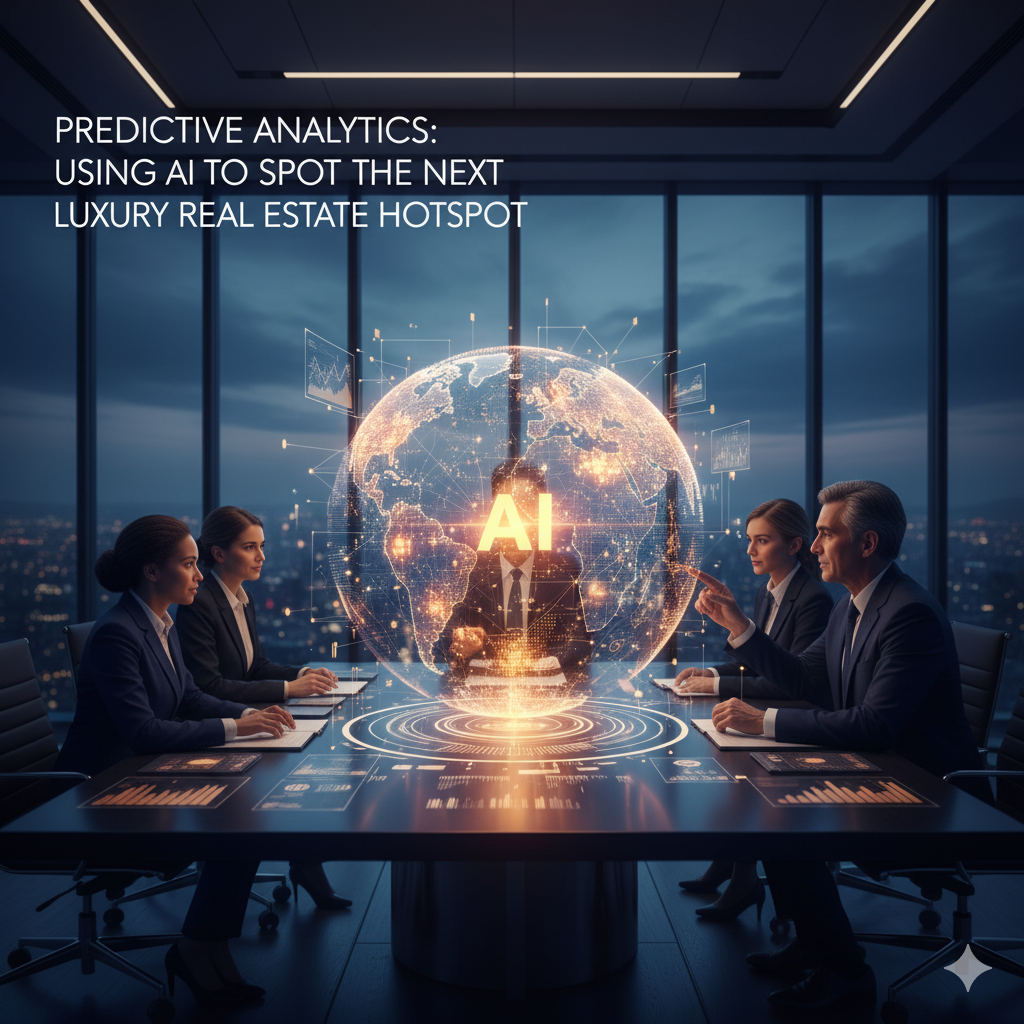Investing in luxury real estate is an endeavor defined by foresight, capital preservation, and the pursuit of exceptional value. The traditional approach—relying on established market cycles, historical sales data, and local expert intuition—has served investors well for decades. However, in today’s rapidly changing global landscape, a new, more powerful methodology has emerged to identify the elusive “next big thing” long before it becomes mainstream: predictive analytics powered by Artificial Intelligence (AI).
This is not a fleeting trend; it is a fundamental shift in how strategic investment decisions are made. For the sophisticated investor, the question is no longer if a market will rise, but when, why, and by how much. The answer lies in the deep, objective intelligence that only AI can unlock.
Moving Beyond Intuition: The Case for Data-Driven Foresight
The luxury market is uniquely sensitive to subtle changes. A new flight path, a policy change on foreign ownership, the relocation of a key corporate headquarters, or even a shift in the cultural zeitgeist can transform a quiet enclave into a global luxury destination. Human analysis, no matter how expert, struggles to process and correlate the sheer volume of these disparate signals in real-time.
Predictive analytics overcomes this limitation by employing machine learning algorithms. These complex models are trained on billions of data points—far exceeding the capacity of any human team—to identify non-linear relationships and hidden patterns that precede market shifts. The result is a level of forecasting accuracy and speed that fundamentally re-calibrates the risk-reward equation for high-net-worth investors. A study from the MIT Real Estate Innovation Lab, for instance, demonstrated that properties identified as ‘high potential’ through these algorithms can yield significantly higher returns compared to those selected using traditional methods.
The New Data Ecosystem: What AI Analyzes
To spot the emerging luxury hotspot, AI models don’t just look at yesterday’s sales figures; they capture the leading indicators of tomorrow’s demand. This requires fusing traditional real estate metrics with dynamic, non-traditional data streams, creating what we call ‘Predictive Market Intelligence.’
1. Wealth Migration and Demographic Signalling
- HNWI Inflow Tracking: AI models analyze anonymized data on the movement of high-net-worth individuals (HNWIs). This includes tracking private jet traffic data, international currency flow trends, and changes in tax residency declarations. A persistent, unexplained surge in high-value activity in a low-profile area is a powerful leading signal of future luxury demand.
- Socio-Economic Shifts: Beyond simple population growth, the AI looks at qualitative factors like the influx of specific professional demographics (e.g., tech entrepreneurs, private equity executives) who drive demand for ultra-luxury amenities.
2. Infrastructure and Policy Signal Monitoring
A new luxury market rarely emerges purely by accident; it’s often catalyzed by significant capital expenditure. AI systems monitor and parse complex, unstructured data, such as:
- Government Filings: Analyzing local and regional zoning changes, environmental impact reports, and large-scale construction permits can signal multi-year infrastructure plans—a new high-speed rail link, a major hospital expansion, or a luxury resort development—long before they are widely publicized.
- Regulatory Risk Assessment: The AI continually screens for political or regulatory risks, such as changes to foreign ownership laws, rental restrictions, or capital gains tax policies, allowing for proactive risk mitigation.
3. Real-Time Sentiment and Lifestyle Data
The value of luxury real estate is deeply intertwined with a location’s lifestyle appeal and cultural cachet. This is where AI truly shines through its use of Natural Language Processing (NLP):
- Social Sentiment Analysis: The system scrapes and analyzes millions of data points across social media, luxury travel blogs, and high-end consumer reports to detect a surge in positive sentiment for a specific location. For example, a sudden rise in mentions of an obscure coastal town as a “top wellness destination” can foreshadow a boom in high-end rental and second-home demand.
- Amenity and Brand Proximity: AI uses computer vision and geospatial analysis to map the appearance of high-end indicators: the opening of a Michelin-star restaurant, a flagship store for a global luxury brand, or the announcement of a world-class golf course designer’s involvement in a new development. These data points act as a magnet for UHNW buyers.
4. Environmental and Climate Risk Integration
A modern, trustworthy investment strategy cannot ignore climate risk. Advanced AI platforms now integrate asset-level scores for physical risks, such as flood plain changes or wildfire vulnerability, directly into the valuation model. This not only protects capital but reflects the Expertise required to navigate long-term investment cycles in an era of environmental change.
The Predictive Model: From Data to Decision
The core value of predictive analytics lies in its ability to synthesize these diverse data points into a single, Actionable Predictive Insight (API).
The Mechanism of Forecasting
- Normalization and Weighting: The AI first normalizes the varied data (from square footage to social media sentiment) and assigns a predictive weight to each factor. For a luxury market model, the “proximity to an elite private school” will be weighted far higher than, say, a local sales volume fluctuation.
- Pattern Recognition: Machine learning algorithms, particularly deep learning, then look for complex, non-linear correlations. For example, it might discover that a combination of “increased private jet traffic, a specific zoning approval, and a 20% rise in local tech sector employment” has historically preceded a 50% jump in property values within an 18-month window.
- Future Value Estimation: Unlike a standard valuation model, the predictive AI doesn’t just tell you the current value; it forecasts the future appreciation curve for properties within that specific submarket, often with a two-to-three-year horizon.
Explainable AI (XAI): Building Trust
A common concern among seasoned investors is the “black box” nature of complex technology. How can one trust a recommendation without understanding the underlying logic? This is where Explainable AI (XAI) becomes the cornerstone of Trustworthiness.
Modern predictive systems are designed to provide a rationale for every forecast. If the AI flags an area as the next hotspot, the system doesn’t just give an answer; it provides a concise, data-backed explanation: “The $12M valuation forecast is driven primarily by the new coastal conservation policy (limiting future supply), a 15% year-over-year increase in inbound HNWI migration, and the Q3 permit filing for the new high-speed transit hub.” This transparency allows the investor and their advisor to validate the logic, blending technological objectivity with human Expertise.
Strategic Implications for the Luxury Investor
The advent of predictive analytics reshapes the strategic roadmap for anyone dealing in ultra-high-net-worth real estate.
Timing the Market with Precision
The perennial challenge in real estate is market timing. Entering a market too late means higher entry prices and diluted margins. Entering too early ties up capital in speculative bets. AI offers the ability to identify the exact point in the market cycle when the growth trajectory is about to accelerate.
- Early Entry Advantage: By identifying a new luxury corridor months or even years before major financial news outlets catch on, investors can secure prime land or undervalued assets, positioning them to capture maximum capital appreciation.
- Proactive Divestment: Similarly, the AI monitors signals that indicate a market is reaching maturity or approaching a potential correction (e.g., oversupply indicators, slowing HNWI inflows), providing a vital lead time for strategic, low-friction exit planning.
De-Risking the Development Pipeline
For luxury developers, AI is a powerful tool for de-risking major projects. Before committing hundreds of millions of dollars, the predictive model can:
- Optimize Site Selection: Precisely evaluate land parcels based on projected demand for specific luxury amenities, factoring in everything from local school quality to the number of nearby private marinas.
- Design Optimization: Predict which luxury features (e.g., biometric security, specific smart home integrations, wellness suites) will drive the highest resale value in a target demographic based on current and forecasted lifestyle trends. This is a critical investment of AI in the long-term success of the development.
The Integration of Human Expertise
It is vital to stress that AI does not replace the seasoned real estate professional; it amplifies their capability. The human element—the art of negotiation, the trusted relationship with a high-net-worth client, the final on-the-ground inspection—remains irreplaceable.
The true Authoritativeness in the new luxury real estate ecosystem comes from the synthesis of two elements:
- AI’s objective, unparalleled analytical power.
- The investor’s (and their advisor’s) deep, nuanced understanding of macroeconomics, risk tolerance, and the non-quantifiable beauty of a property.
The AI provides the map; the experienced investor navigates the journey. This powerful partnership ensures that investment decisions are not based on outdated data or emotional conviction, but on a foundation of rigorous, forward-looking intelligence.
A Look Ahead: The Evolution of AI in Luxury Real Estate
The sophistication of AI in real estate is only increasing. We are moving towards a future where:
- Hyper-Localization: Predictive models will offer granular forecasts down to the block or individual street level, identifying a “hotspot within a hotspot.”
- Agentic AI: Future systems will not just offer predictions but will actively monitor market changes and autonomously adjust the investment thesis in real-time, alerting the investor only when a predefined threshold (opportunity or risk) is met.
- Seamless Integration: The data insights from the AI will become the default starting point for every conversation, every valuation, and every strategic decision in the luxury sector.
The world of luxury real estate is undergoing a quiet, yet profound, transformation. The key to staying ahead of the curve is embracing the new analytical edge provided by AI. By combining data-driven prediction with institutional discipline and human acumen, you can move beyond speculation and invest with unprecedented confidence, positioning yourself perfectly to secure the next generation of prime global assets. The ability to spot the next luxury real estate hotspot is no longer a matter of luck, but a mastery of AI and predictive science.
Moses Oyong is a luxury real estate advisor with a passion for arts and culture, music, fashion, and all things luxurious. With a keen eye for beauty and attention to detail. I strive to help my clients find their dream homes that reflect their unique sense of style and taste whilst providing them with the right information to ease the stress of the decision-making process.




